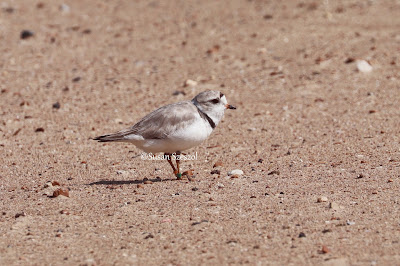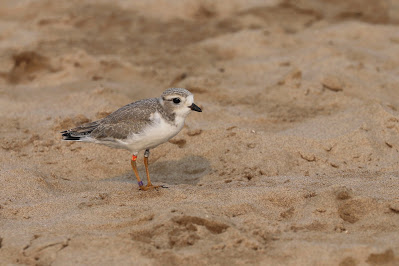 |
| Rose (left) and Monty, 24 July 2019. Photo copyright 2021 by Susan Szeszol. All rights reserved. |
Every now and then I fall in love with an individual, identifiable bird—BB, my banded Pileated Woodpecker; the Black-capped Chickadee with a deformed bill and 3 missing toes who successfully nested and fledged at least five chicks; the robin who always did his singing at the very top of my largest spruce tree. BB occasionally still visits, so I presume from day to day that he’s alive. I haven’t seen that chickadee since his babies fledged in 2015. He may have died that year, but it’s equally likely that his mate came from a different winter flock and he moved on with her. It is improbable that he’d be living now, 7 years after that, but not impossible—at least one banded chickadee lived to be 12 years old. I think I’m glad that I’ll never know for certain. I do know exactly what happened to my robin—he was killed by a Cooper’s Hawk who started feasting on his pectoral muscles while he was still alive. I’d have been happier had I never witnessed that gruesome scene or at least didn’t personally know the victim.
 |
| Monty, 24 July 2019 Photo copyright 2022 by Susan Szeszol. All rights reserved. |
I fell in love with two individual birds without ever meeting them in person: Monty and Rose, the famous Piping Plovers who successfully nested on Montrose Beach in Chicago from 2019 through 2021. Many Piping Plovers are banded with colored as well as numbered aluminum bands so birders and photographers can track down which individuals they see. That’s how we know that Rose spent winters in Florida, and Monty in Texas.
Monty returned to Chicago this year on April 21, and the many plover monitors and other people paying close attention were joyful. But day after day, there was no sign of Rose. Weather patterns this spring have slowed migration, but people quickly started growing concerned. Piping Plovers who successfully raise young in an area virtually always return to that same spot the following year, so it grew increasingly clear that something bad had happened to Rose.
 |
| Monty watching his sleeping chicks, 8 August 2021 Photo copyright 2022 by Susan Szeszol. All rights reserved. |
As bonded to their mate as Piping Plovers must be to successfully nest, they can’t afford to dilly dally when their mate from the previous year doesn’t turn up. Indeed, on the Atlantic beaches where Piping Plovers are much more abundant than on the Great Lakes, one bird often accepts a new mate almost immediately after arriving without waiting even a day or two for its previous year’s mate to show up. When that bird does arrive, it doesn’t take umbrage—it simply finds its own new mate. But the entire Great Lakes population of Piping Plovers numbers fewer than 200 individuals. There weren’t any potential mates waiting in the wings for Monty, and none turned up over the following three weeks—birders and Piping Plover monitors were eagerly keeping watch in anticipation of this year’s nesting season officially beginning.
On Friday, May 13, plover monitor Daniela Herrera was birding on the dunes when she saw Monty fall over a number of times. He appeared to be gasping for air, and suddenly, just like that, he was dead. I can’t imagine how devastating this must have been to witness. Leslie Borns, the beach steward who spearheaded the protection of dunes vegetation back in the 1990s (her tireless work finally made it possible for Piping Plovers to nest in such a huge city—you can learn more about her in the Chicago Reader ) arrived minutes later. They retrieved the poor little body to be sent to the Lincoln Park Zoo for a necropsy.
Both Monty and Rose hatched in 2017, and in news articles, a lot of people have been quoted saying the life expectancy of Piping Plovers is 5 years, but that’s a meaningless oversimplification. Most hatchlings don’t survive their first year, but once a Piping Plover reaches about two years of age and has successfully bred, its life expectancy rises dramatically. Indeed, five-year-old Piping Plovers are at the very prime of life. Banded birds have survived well into their teens, and the oldest known Piping Plover was alive and healthy when photographed in Cuba in 2016 at a minimum age of 17!
My sadness is a combination of having spent a lot of time with these beautiful and charismatic little plovers in Maine; understanding how critically important each individual is in such a rare species, especially in the endangered Great Lakes population; and my personal connection to Montrose Beach, directly across Lake Shore Drive from where my beloved uncle lived for 30 years.
 |
| Susan Szeszol monitoring plovers during the lovely days of last summer. |
As sad as this news was for me, I can’t imagine how horrible it’s been for the monitors who spent so many hours, days, weeks, and months watching these birds’ every move and becoming so intimately acquainted with them. My treasured friend Susan Szeszol was a plover monitor who spent a great many hours watching and photographing Monty, Rose, and their chicks and generously sharing her work with me.
 |
| 28-day-old Imani, 4 August 2021 Photo copyright 2022 by Susan Szeszol. All rights reserved. |
The pain Susan and her fellow monitors are feeling is an order of magnitude greater than mine—they share all my love for this adorable shorebird and understand the conservation value of each one, plus they feel a deeply personal connection to Monty and Rose. How can they not be devastated? My friend Susan told me:
Too many people have said to me, “It’s part of the life cycle” or “Life goes on.” They truly don’t understand the deep personal connection. When I went to the beach last weekend for the first time since his passing and her apparent passing, it was overwhelming for me. I stood at all of the places that the monitors and I had watched them over the years, sitting on the eggs, little chicks warming up underneath mom, …. and it was just so empty without them there.
On May 31, results of the necropsy were released. Tests for avian flu were negative. Monty died from a severe fungal infection in his lungs. How and where he picked that up is not known.
 |
| 31-day-old Imani, 8 August 2021 Photo copyright 2022 by Susan Szeszol. All rights reserved. |
Meanwhile, there is some good news—one of Rose and Monty’s babies from last year, Imani, was briefly seen here in Duluth on May 16 until people walking dogs off-leash on the beach scared him away. Exactly one week later, on May 23, he was back in Chicago at Montrose Beach! He’s still hanging out there, but so far, no females have found their way to him. Migration has been late this year so there’s still a little hope for this year, and even if a female doesn’t turn up, it’s wonderful that we know Imani survived the winter and was smart enough to figure out that the people of Chicago are way more willing to make accommodations to help nesting Piping Plovers than the dog owners of Duluth.
 |
| Imani in Duluth, 16 May 2022 © 2022 by Clinton Dexter-Nienhaus. All rights reserved. |
